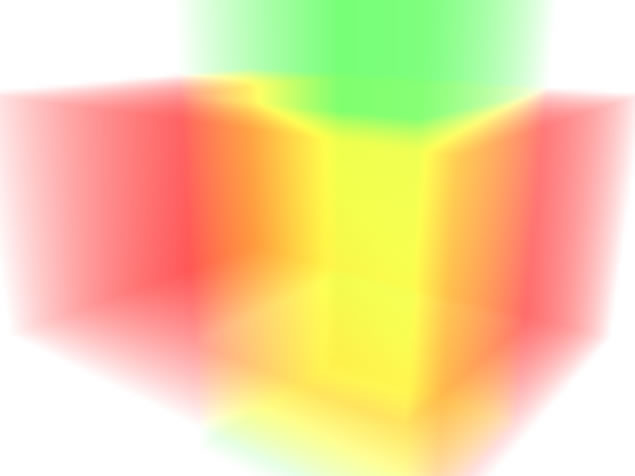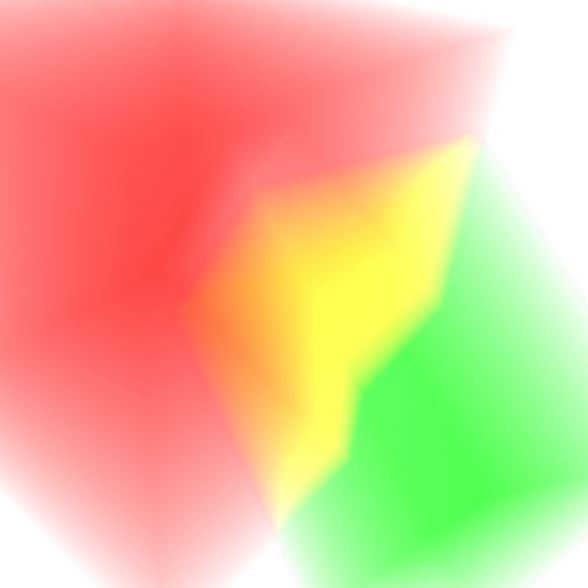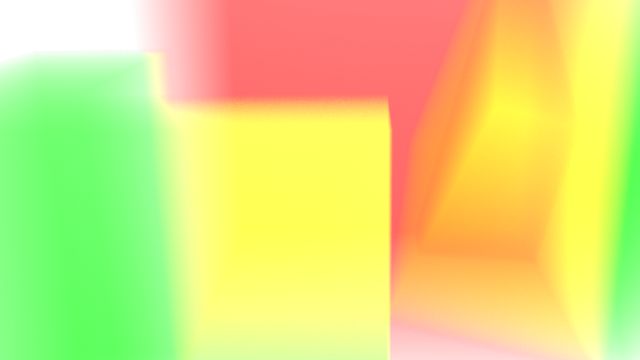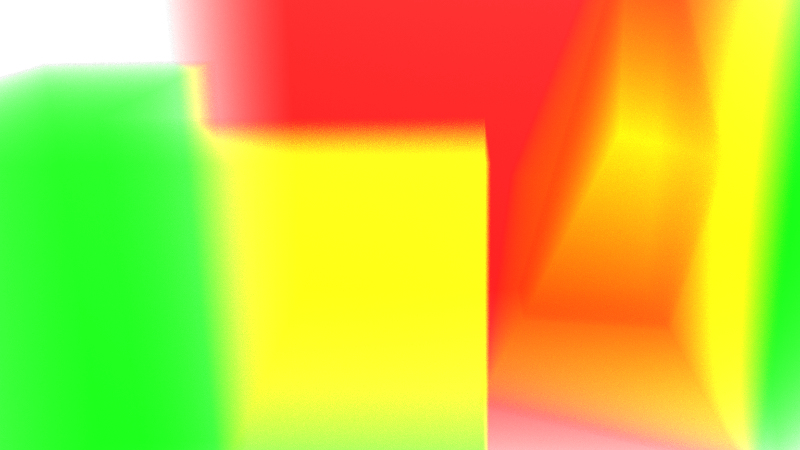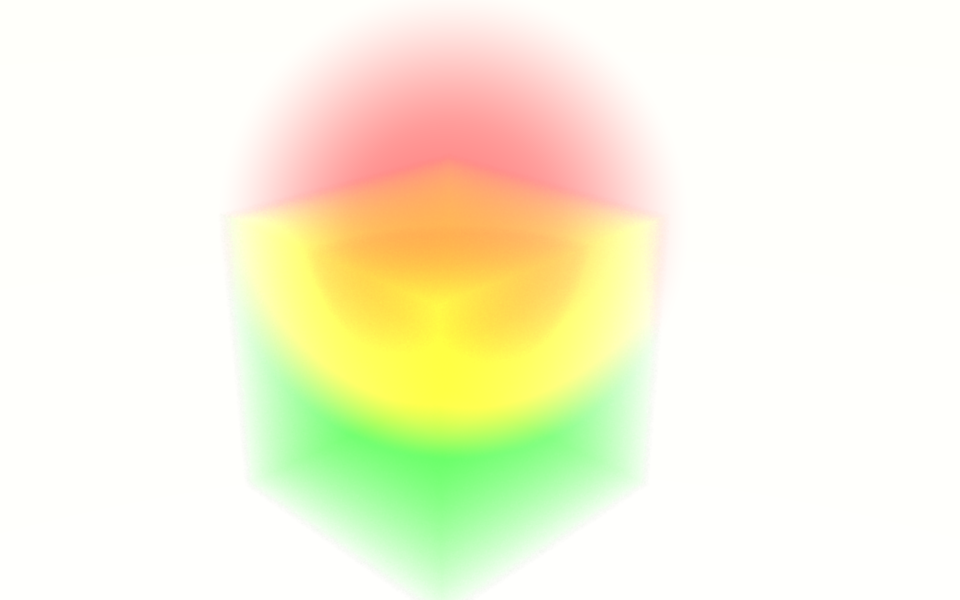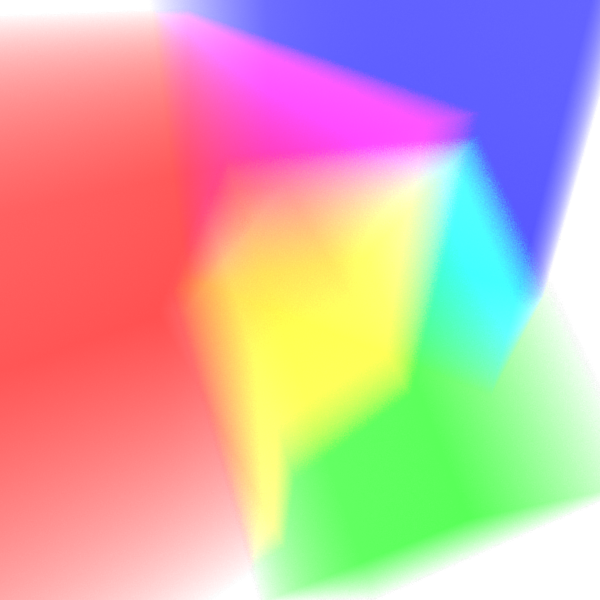In meiner Freizeit befasse ich mich immer mal wieder gerne mit Simulationsprogrammen. So hatte ich ein paar Jahre lang viel Freude an dem “Windows”- und “Apple”-Programm “Bryce”. Blender erschien mir – gemessen an meinen unprofessionellen Interessen – zu komplex und bzgl. einer Einarbeitung zu aufwendig. Jetzt habe ich mal wieder einen Anlauf unternommen und mich mit der Blender-Version 2.5 auseinandergesetzt. Als Einstieg habe ich ein Thema aufgegriffen, dass ich früher schon einmal mit Bryce behandelt habe.
Ein 3D Raytracing-“Experiment” mit Bryce
Vor ein paar Jahren hat mich Michael Grossmann anläßlich eines seiner Kunstprojekte auf eine interessante “Problemstellung” für Simulationsprogramme aufmerksam gemacht:
Was geschieht wenn man grüne und rote Glasscheiben übereinander legt? Und was geschieht im Gegensatz dazu, wenn man Schichten aus selbstleuchtenden Gasen übereinander legt?
In entsprechenden Experimenten kann man den Unterschied zwischen “aktiver” und “passiver” Farbmischung studieren. In der Malerei, beim Druck, aber auch in Photobearbeitungs- oder Publishing-Programmen beschäftigt man sich vor allem mit der passiven Farbmischung, während z.B. die Bilderzeugung auf LCD-Schirmen auf dem Prinzip der aktiven Farbmischung beruht. In vielen Fällen führt deshalb das Arbeiten am PC schnell auf eine Einbahnstraße vom RGB-Farbraum zum druckrelevanten CYMK-Farbraum. Gerade aus künstlerischer Sicht interessiert am PC die “aktive” Farbmischung als eigenständiges Thema leider kaum.
Ein paar “Versuche” mit Photoshop und danach Bryce haben Michael und mich 2003 dazu veranlasst, das Thema “aktive” Mischung in 3D mal anhand folgender konkreter Fragestellung anzugehen:
Was geschieht, wenn man einen Quader aus selbstleuchtendem roten Gas in eine passende, asymmetrisch positionierte Ausbohrung in einen Quader aus selbstleuchtendem grünen Gas setzt? (Beide Gase seien transparent.)
Die Physik und Grundlagen der menschlichen Farbwahrnehmung sagen einem, dass man auf diesem Wege – je nach Dicke der betrachteten grünen oder roten Schichten – ein Farbspektrum von Rot über Orange, Gelb, Grün erzeugen können muss – je nachdem wie sich die Lichtstrahlen aus den farbigen Gasbereichen überlagern. Faktisch sollte bei einer asymmetrischen Konfiguration der Blickwinkel dafür ausschlaggebend sein, was man sieht.
Michael und ich haben damals die Raytracing-Methoden von Bryce zur wirklichkeitsnahen Simulation dieser Aufgabenstellung angewendet. Die gewünschten selbstleuchtenden Gase habe ich mit Hilfe des äußerst vielseitigen Materialeditors von Bryce erzeugt. Siehe zu den Ergebnissen unserer Simulationen :
seeking yellow
So akademisch die ganze Idee anmuten auch mag – sie ist in mehrerlei Hinsicht interessant: physikalisch, künstlerisch, philosophisch – denn aus entsprechenden Simulationen kann man einmal mehr etwas darüber lernen, das nicht alles so ist, wie es zu sein scheint und dass die Bilder, die unsere Sinneswahrnehmung in unserem Bewußtsein erzeugt, “künstliche”, durch unser Gehirn und Sinnesverarbeitung vorinterpretierte Bilder sind. Obwohl wir etwas “Gelbes” im Zentrum unserer simulierten “Versuchsanordnung” sehen, sendet keines der simulierten Objekte einen gelben Lichtstrahl aus! Zur Erklärung siehe den obigen Link.
Simulationstechnisch hat die Aufgabenstellung einiges zu bieten: Mit Hilfe
geeigneter Simulationsprogramme wie Bryce kann man hier etwas darstellen, was technisch nur schwer zu realisieren wäre. Und ferner erlaubt uns Bryce, eine Kamera in die Gas-Objekte hinein zu bewegen und Blickwinkel aufzunehmen, die in einer realen Welt kaum zugänglich wären. Ferner steht entsprechenden Kamerafahrten durch die Gaskörper nichts im Wege. Und nicht zuletzt macht die Sache Spass – denn die Ergebnisse können farblich wirklich spektakulär sein. Siehe hierzu die Bilder unter seeking yellow
Blender statt Bryce
Trotz meines Fables für Bryce fanden Michael und ich es als Linux-Anhänger damals etwas ärgerlich, dass wir es nicht geschafft haben, unser “seeking yellow”-Projekt mit Opensource-Programmen durchzuziehen. Im besonderen kamen wir mit dem Material-Editor der damaligen Blenderversion nicht klar.
Außerdem gab es damals einige Leute, die das Ergebnis der Simulation schlichtweg für Unsinn erklärt haben, da sie mit aktiver Farbmischung nicht vertraut waren. Daher erschien es uns wichtig, die Ergebnisse unseres “Ray-Tracing-Experiments” durch ein unabhängiges Simulationsprogramm bestätigen.
Vor ein paar Tagen habe ich deshalb erneut versucht, unsere damaligen “Experimente” ansatzweise mit “Blender” in der Version 2.5 nachzuvollziehen.
Dieses Unterfangen erwies sich als viel leichter als anfänglich vermutet. Blender bestätigt die früheren Ergebnisse der Bryce-Simulationen von Michael und mir in vollem Umfang. Zudem können wir nun viel einfacher und ganz ohne Windows auch komplexe Konfigurationen studieren.
Diese “Experimente” mit Blender mögen auch für andere interessant sein. In einigen weiteren Artikeln in der Kategorie “Blender” dieses Blogs werde ich beschreiben, wie man etwa zu folgenden Bildern kommt:
Obwohl in diesen Ansichten einer Kombination von roten, grünen, blauen Quadern oder Kugeln eingesetzt wird und alle möglichen gelben, orangen und violetten Farben erscheinen, gibt es im ganzen “Versuchsaufbau” der Simulationen kein einziges Objekt, das gelbe oder violette Strahlen aussenden würde. Aber in einer 3D-Welt mit aktiven Farbmischungen ist eben so einiges
möglich. An anderen Beispielen kann man zudem zeigen, dass es mit einfachen eckigen Körpern gelingen kann, runde kaustik-ähnliche Kurven zu erzeugen.
Optik in 3D macht Spaß mit Blender !

